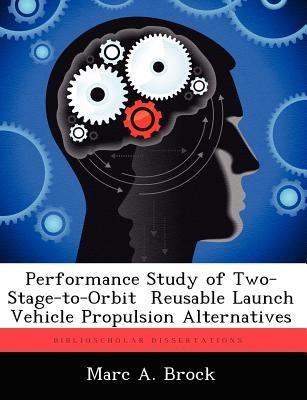
- We will send in 10–14 business days.
- Author: Marc A Brock
- Publisher: BiblioScholar
- ISBN-10: 1249374197
- ISBN-13: 9781249374190
- Format: 18.9 x 24.6 x 0.6 cm, softcover
- Language: English
- SAVE -10% with code: EXTRA
Performance Study of Two-Stage-To-Orbit Reusable Launch Vehicle Propulsion Alternatives (e-book) (used book) | bookbook.eu
Reviews
Description
This study investigated the performance of five Two-Stage-To-Orbit reusable launch vehicles (RLV), with stages propelled by rocket engines, turbojet engines and Rocket Based Combined Cycle (RBCC) engines. Horizontal versus vertical takeoff launch and direct versus lifting ascent trajectories were also studied. A method was conceived using a 3 degree of freedom optimization program, stage inert mass fractions, and a fixed gross takeoff weight (GTOW) of 1,000,000 lbf to determine each RLVs performance based on payload weight delivered to orbit and total vehicle inert weight. RLV trajectory constraints, mass fractions, engine performance, and aerodynamics were assumed from literature of similar RLVs or data provided by the Air Force Research Laboratory (AFRL). The method devised predicted performance for all RLVs studied, but was time intensive and intolerant of small trajectory modifications. A horizontal takeoff RLV with the 1st stage powered by turbojet engines and the nd stage propelled by a rocket engine, in a lifting ascent trajectory, provided 3 times the payload weight to orbit when compared to the same vehicle in a vertical takeoff mode. The RLV with both stages propelled by rocket engines lifted more payload weight into orbit with a lower inert weight than all other RLVs studied. RLVs propelled by RBCC engines, on a direct ascent trajectory, had insufficient fuel to reach orbit because of the high inert weight of the RBCC engines.
EXTRA 10 % discount with code: EXTRA
The promotion ends in 15d.16:52:38
The discount code is valid when purchasing from 10 €. Discounts do not stack.
- Author: Marc A Brock
- Publisher: BiblioScholar
- ISBN-10: 1249374197
- ISBN-13: 9781249374190
- Format: 18.9 x 24.6 x 0.6 cm, softcover
- Language: English English
This study investigated the performance of five Two-Stage-To-Orbit reusable launch vehicles (RLV), with stages propelled by rocket engines, turbojet engines and Rocket Based Combined Cycle (RBCC) engines. Horizontal versus vertical takeoff launch and direct versus lifting ascent trajectories were also studied. A method was conceived using a 3 degree of freedom optimization program, stage inert mass fractions, and a fixed gross takeoff weight (GTOW) of 1,000,000 lbf to determine each RLVs performance based on payload weight delivered to orbit and total vehicle inert weight. RLV trajectory constraints, mass fractions, engine performance, and aerodynamics were assumed from literature of similar RLVs or data provided by the Air Force Research Laboratory (AFRL). The method devised predicted performance for all RLVs studied, but was time intensive and intolerant of small trajectory modifications. A horizontal takeoff RLV with the 1st stage powered by turbojet engines and the nd stage propelled by a rocket engine, in a lifting ascent trajectory, provided 3 times the payload weight to orbit when compared to the same vehicle in a vertical takeoff mode. The RLV with both stages propelled by rocket engines lifted more payload weight into orbit with a lower inert weight than all other RLVs studied. RLVs propelled by RBCC engines, on a direct ascent trajectory, had insufficient fuel to reach orbit because of the high inert weight of the RBCC engines.


Reviews